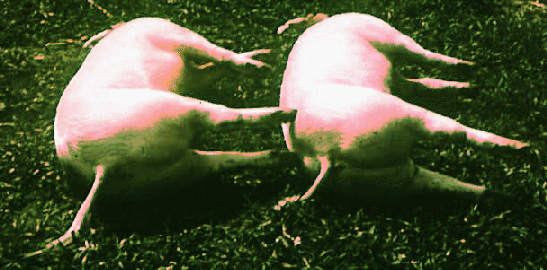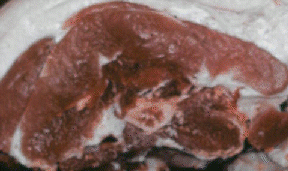
The main purpose for investigating postmortem metabolism of muscle is to help explain and control things such as PSE that have a practical, commercial importance in the meat trade. Watery pork that appears unusually pale and which has a high fluid loss when cut and presented for sale has been around for a long time, with the first scientific reports dating back to the early 1900s. In the scientific literature the condition is most commonly called PSE, standing for pale, soft, and exudative pork.

In the journey from the farm gate to the customer's plate there are many factors that may detract from pork quality and only a few that can add to it. Assuming that processors and retailers achieve a high standard of cleanliness, packaging and presentation (as is usually the case), what features of pork can be observed or detected by the customer? Remember, even subtle factors may, over the course of time, produce major changes in purchasing patterns and food consumption.
If the answers are not immediately obvious, look carefully at some pork chops as you are cutting them. Find some chops that have a fairly dark pork colour, which have a solid shape and which are relatively dry to the touch. Then see if you can find some others that are pale with a washed-out appearance, which are soft and shapeless, and which are leaking a watery fluid. Most customers don't like the pale, soft, watery ones. The fluids that exude or drip from meat are called an exudate - hence the name PSE pork: pork that is pale, soft and exudative.
PSE pork that was avoided in the fresh state by a customer because of its unattractive appearance is just as likely to be rejected by a meat processor. One of the great secrets of making good meat products is to get a good structure or texture. If pork has been minced or cut to make a processed product, the pieces must be made to stick to each other in the finished product - whether it is a sausage or a canned ham. Water is needed to create succulence, but the water must be within the meat fragments not between them. Take a piece of pale pork with a soft structure and fluid exuding from it, make a processed product from it, and see what you get. Usually it is a product with an insipid pale colour, that is falling apart, and which is swimming in surplus fluid.
A good use for PSE pork in processed products has not yet been found. Even in dry sausage, where the use of PSE pork enables shorter drying times, there is a deterioration to a soft, crumbly texture in the finished product. When PSE pork is used in processing, it must be mixed with quantities of normal pork sufficient to maintain product quality.
Having introduced PSE, let us now examine two other important terms in the same general area.
Pale, Soft, Exudative pork - a food technologist's term to describe pork quality,
we see that it is not the same thing as PSS

{Are these pigs dead, or merely resting like Norwegian Blue Parrots?}
Thus, PSE relates to the meat, while PSS relates to the animal from which the meat was derived.
The third term to explain is DFD:

If pigs suffering from PSS make it as far as the abattoir, they frequently but not always produce severely PSE pork. Sometimes the pork from PSS pigs is DFD, and sometimes it appears normal. Thus, PSS and PSE are not the same thing, and PSS does not always give rise to PSE.
Absolutely not. In fact, PSE pork usually has a longer shelf life and lower spoilage rates than normal pork.
No. PSS pigs can be detected reliably by various tests (particularly the DNA test) and pigs that pass these tests may still produce PSE pork. Some pig-producing areas have a low (less than 5%) incidence of PSS pigs but, in the summer months, the incidence of PSE carcasses may be much higher (around 30%).
Eliminating hidden carriers of PSS, using new methods such as the DNA test developed by Dr. Peter O'Brien while at the University of Guelph may be used to reduce the incidence of PSS, leading to a reduction of PSE, but careful attention is required for the transport and slaughtering of non-PSS pigs which still are liable to produce PSE if poorly handled.
Probably not. PSS pigs produce the most severe PSE, characterised by extreme paleness from protein denaturation (like the colour changes produced by mild cooking). On the other hand, PSE pork from normal pigs may not become as pale, but the fluid released from between the filaments of the fibrils may be worse. Scientifically, different types of PSE can be identified by differences in their reflectance of violet and red light.
Probably the way they are transported and slaughtered, but there are no simple relationships. One abattoir may have a low incidence of PSE pork while a nearby plant supplied from the same population of pigs may have a high incidence. Thus, there is an effect due to handling that contributes to PSE produced from normal pigs.
PSE is almost always worse at the height of the summer or when the climate is variable. Thus, there is probably a seasonal effect that contributes to PSE produced from normal pigs.
In some abattoirs, where pigs are shackled by one ham and the other is free to kick, the incidence of PSE is worse on the free, kicking side. Thus, there must be an effect from struggling that contributes to PSE from normal pigs.
Unfortunately, these factors are too complex to enable any universally true predictions, but here are a few that are often quite useful:
The best way is the method that causes the least amount of suffering and reflex struggling by the pig. There are no foolproof methods, because even inferior equipment used skilfully may cause less PSE than expensive equipment that is used incorrectly. However, assuming that the equipment is properly adjusted and skilfully used, stunning methods that damage the skull (such as captive bolt pistols and knocking hammers) generally produce more struggling and more PSE than modern methods using electrical and carbon dioxide stunning. In comparing different methods, look at the amount of struggling that occurs, including the muscle contractions that occur during and after sticking and bleeding. Another point to look for is to check that the stunning method does not cause the rupture of very small blood capillaries by elevating the blood pressure at the start of slaughter. Blood speckles in pork, while they pose no health risk, are visually unacceptable to most customers.
If it reduces the overall amount of struggling it will probably reduce the amount of PSE. As yet, there have been no major problems with getting a normal bleed-out, but this requires constant vigilance.
Sometimes. Sorting costs money, and you need to gain more than you spend. The benefits may be a higher payment for shipments which contain few PSE cuts or greater yields in further processing.
Yes, but not very reliably immediately after slaughter. Severe PSE from PSS pigs develops very rapidly and can be detected fairly reliably 45 minutes after the start of slaughter, but the milder PSE from normal pigs is less predictable. Sometimes it is already apparent at 45 minutes, but more often it develops after 45 minutes. Once cutting of the carcass has started, it may be difficult to retrieve all the cuts from a PSE carcass, so sorting should be done before cutting starts. Sorting around 24 hours after slaughter can be quite precise.
Several, but only three that are fast enough and robust enough to be of any practical value.
In all three methods, the time at which the measurement is made is critical. If the time lapse between slaughter and measurement is not constant, then the results become meaningless.
Unfortunately, there is no universally valid answer. First you must implement one of the objective methods for measuring PSE and determine how the incidence of PSE changes during the day and during the week. From this information you can sometimes find a factor that contributes to the formation of PSE pork. For example, the PSE carcasses may come from those animals that were shipped, unloaded and slaughtered without being rested.
Alternatively, objective methods for measuring PSE can be used for in-house experiments. For example, you might wish to change an operating procedure and see the result (if any). Every abattoir seems to be unique and there are few solutions that work for everyone.
If some of the PSE is originating from PSS pigs, it does not take too much detective work to identify the suppliers once you have an objective method for measuring PSE.
A key point to remember is that, if the incidence of PSE pork is severe enough to be of concern, then there are probably a number of contributory factors that must be attacked one by one. PSE pork is most unlikely to disappear completely after making a single improvement.
DFD also occurs in beef as a result of glycogen depletion before slaughter.Usually it is called DARK-CUTTING. The glycogen depletion is usually caused by strenuous muscle activity (fighting or shivering).
PSE and DFD are probably generalized conditions of muscle and can occur in any species. PSE poultry meat seems to be more common than it used to be, and strains of turkeys with very fast glycolysis have been identified (although whether it is caused by the same factors that cause PSS in pigs remains to be seen).